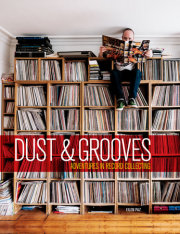Preface
by Eilon Paz
My older brother got the guitar. My middle brother got the drums. I was left with that legendary rock and roll instrument known as . . . the recorder.
Learning to play the Israeli national anthem and other Eastern European hit melodies, conducted with pride by my Russian music teacher, wasn’t exactly the epitome of rock and roll excitement. And thus, my promising musical career came to an end at the tender age of six. Still, I eventually found ways to keep myself surrounded with music in the small desert town in Israel where I grew up: collecting records, hanging out with my musician friends, and occasionally even picking up a bass guitar from time to time.
So perhaps it’s no surprise that, not long after I published my first book,
Dust & Grooves—which documented the fascinating stories of vinyl collectors from around the world—I began to turn my attention to the book you hold in your hands.
Dust & Grooves, which started out simply enough as a personal photo project, ended up having an incredible impact on the vinyl community. It allowed collectors to peek into their fellow collectors’ personal space, revealing the stories behind the music as well as each collector’s personal history with their beloved vinyl.
And it was a serious teaching moment for me, too. See,
Dust & Grooves wasn’t aimed at the casual music fan. Instead, the folks who bought that massive book cared deeply about the subject matter, and appreciated every word and photo in it. The project taught me that diving into a community of passionate, like-minded people will always spark my own passion for the work. With that in mind, I was looking for a theme or subject that combined music, a passionate community, collecting, and potent myths.
Guitar pedals, and the pedal community, checked all those boxes. I’d seen coffee-table books about famous guitarists and their guitars, sure, and there are a number of tech-savvy reference books about guitar pedals, but I had never seen a fine photo book specifically about guitar pedals. Having come of age in the grunge era, I was as motivated by the sound of fuzz boxes and other pedals as I was by the look of them. I even still had that old bass guitar, which sat in the corner and winked at me from time to time.
I could instantly visualize the look and feel of the book. My photographs would be the through line that guides you into the personal stories behind the stompboxes, objects that carry so much history, whether through their design, their graphics, their texture, their scars, their accumulated schmutz, or all of the above. My goal in photographing each pedal was to reveal the hardship involved in touring and creating music—to show every speck of dust, rust, and sometimes even blood that’s built up on the pedal’s surface. As a portrait and documentary photographer, photographing pedals was a door to still-life photography, which for years I considered a boring technical discipline. Now, the challenge was upon me—to pull the stories and musical history out of these still objects, which are so rarely seen or appreciated by anyone outside of the musicians who use them. After all, you can smash a guitar into pieces, kick and abuse the drums, but what kind of drama—other than sonics—can you get from a pedalboard?
The first decision I made was that the pedals would be the real stars of the book; there would not be any photos of the guitarists themselves. Zeroing in on a consistent visual aesthetic was also challenging. I started experimenting with different lights and surfaces, with the goal of bringing the most texture and grit out of the pedal’s surfaces. I ended up with a very straightforward approach: shoot the pedal on a white background, while using very strong and contrast-y lighting that would penetrate every crack and scratch, in order to truly bring out the pedal’s history and character through its exterior. I also needed a professional setup that would be extra light and could be set up and broken down in minimal time, and also be packed into a small suitcase that could be carried around the world on a small budget. In the end, I would travel the globe, often away for two months at a time, making multiple stops across the USA, as well as Japan, Russia, Europe, the UK, and back to my home in Brooklyn. Still, how does a photographer with only basic pedal knowledge (and admittedly limited guitar moves) go about making a credible book about guitar pedals? Well, he gets the best writers, editors, and advisors in the industry on his team. In my fortunate case, author Barry Cleveland helped shape the book’s concept and set the bar at the highest level. Dan “Mother$%#^ing” Epstein and James “Roto” Rotondi, our dedicated editors, brought some serious smarts to the project, and put in countless hours on its behalf; they made sure that no detail was overlooked, as did our technical editing team. Our awesome cast of contributing writers repeatedly went the extra mile, both in securing and conducting interviews, as well as fact-checking and helping facilitate photo shoots, and, of course, turning in top-notch copy.
So, here we are. After three years in the works, over a hundred interviews, eight countries visited, one pandemic, and hundreds of pedals meticulously photographed, I’m left with a very satisfying realization of my vision for the book as a photographer, and even more of an itch to hear all these super-cool pedals in action. Perhaps it’s time to put the camera aside for a bit and pick up that ready-to-rumble bass guitar that’s been egging me on from across the room for the last few years. Yeah, I think it’s exactly the right time.
Copyright © 2021 by Eilon Paz, edited by Dan Epstein and James Rotondi. All rights reserved. No part of this excerpt may be reproduced or reprinted without permission in writing from the publisher.













